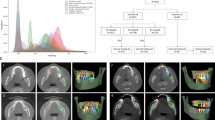Abstract
Purpose
State of the art computer aided implant planning procedures typically use a surgical template to transfer the digital 3D planning to the operating room. This surgical template can be generated based on an acrylic copy of the patient’s removable prosthesis—the so-called radiographic guide—which is digitized using a CBCT or CT scanner. Since the same accurate fit between the surgical template and the patient as with the radiographic guide and the patient should be ensured, a procedure to accurately digitize this guide is needed.
Methods
A procedure is created to accurately digitize radiographic guides based on a calibrated segmentation. Therefore, two steps have to be executed. First, during a calibration step a calibration object is CBCT or CT scanned and a calibration algorithm which results in an optimal threshold value is executed. Next the guide is CBCT or CT scanned and a 3D model is created using the obtained optimal threshold. To validate our method, we compared a high accuracy laser scanned copy of the guide with the generated 3D model by creating a distance map between both models.
Results
The procedure was performed for different CBCT and CT scanners, and the digitization error for each scanner was defined. The 90th percentile error measured on average 0.15 mm, which was always less than the applied voxel size for all CBCT and CT test scans.
Conclusions
The calibration procedure evaluated in this study solves the known problem of digitizing a radiographic guide based on non-standardized gray value CBCT images. The procedure can easily be executed by a clinician and allows an accurate digitization of a radiographic guide using a CBCT or CT scanner. Starting from this digitization, an accurate surgical template can be made which has a good fit on the patient’s remaining teeth and surrounding soft tissues.
Similar content being viewed by others
References
Verstreken K, Van Cleynenbreugel J, Martens K, Marchal G, van Steenberghe D, Suetens P (1998) An image-guided planning system for endosseous oral implants. IEEE Trans Med Imaging 17(5): 842–852
van Steenberghe D, Glauser R, Blombäck U, Andersson M, Schutyser F, Pettersson A, Wendelhag I (2005) A computed tomographic scan-derived customized surgical template and fixed prosthesis for flapless surgery and immediate loading of implants in fully edentulous maxillae: a prospective multicenter study. Clin Implant Dent Relat Res 7(Suppl 1): S111–S120
Nikzad S, Azari A (2008) A novel stereolithographic surgical template for planning treatment involving a mandibular dental implant. J Oral Maxillofac Surg 66(7): 1446–1454
De Riu G, Meloni SM, Pisano M, Massarelli O, Tullio A (2010) Computed tomography-guided implant surgery for dental rehabilitation in mandible reconstructed with a fibular free flap: description of the technique. Br J Oral Maxillofac Surg
Gillot L, Noharet R, Cannas B (2010) Guided surgery and presurgical prosthesis: preliminary results of 33 fully edentulous maxillae treated in accordance with the nobelguide protocol. Clin Implant Dent Relat Res 12(Suppl 1): e104–e113
Johansson B, Friberg B, Nilson H (2009) Digitally planned, immediately loaded dental implants with prefabricated prostheses in the reconstruction of edentulous maxillae: a 1-year prospective, multicenter study. Clin Implant Dent Relat Res 11(3): 194–200
Yong LT, Moy PK (2008) Complications of computer-aided-design/computer-aided-machining-guided (NobelGuide) surgical implant placement: an evaluation of early clinical results. Clin Implant Dent Relat Res 10(3): 123–127
Scotti R, Pellegrino G, Marchetti C, Corinaldesi G, Ciocca L (2010) Diagnostic value of nobelguide to minimize the need for reconstructive surgery of jaws before implant placement: a review. Quintessence Int 41(10): 809–814
Van Assche N, van Steenberghe D, Guerrero ME, Hirsch E, Schutyser F, Quirynen M, Jacobs R (2007) Accuracy of implant placement based on pre-surgical planning of three-dimensional cone-beam images: a pilot study. J Clin Periodontol 34(9): 816–821
Vasak C, Watzak G, Gahleitner A, Strbac G, Schemper M, Zechner W (2011) Computed tomography-based evaluation of template (NobelGuide)-guided implant positions: a prospective radiological study. Clin Oral Implants Res. doi:10.1111/j.1600-0501.2010.02070.x
Pettersson A, Komiyama A, Hultin M, Näsström K, Klinge B (2010) Accuracy of virtually planned and template guided implant surgery on edentate patients. Clin Implant Dent Relat Res. doi:10.1111/j.1708-8208.2010.00285.x
D’haese J, Van De Velde T, Komiyama A, Hultin M, De Bruyn H (2010) Accuracy and complications using computer-designed stereolithographic surgical guides for oral rehabilitation by means of dental implants: a review of the literature. Clin Implant Dent Relat Res. doi:10.1111/j.1708-8208.2010.00275.x
Stumpel LJ (2010) Deformation of stereolithographically produced surgical guides: an observational case series report. Clin Implant Dent Relat Res. doi:10.1111/j.1708-8208.2010.00268.x
Lorensen WE, Cline HE (1987) Marching cubes: a high resolution 3D surface construction algorithm. In: Proceedings of SIGGRAPH: 163–169
Maes F, Collignon A, Vandermeulen D, Marchal G, Suetens P (1997) Multimodality image registration by maximization of mutual information. IEEE Trans Med Imaging 16(2): 187–198
Otsu N (1979) A threshold selection method from gray-level histograms. IEEE Trans Syst Man Cybern 9(1): 62–66
Besl PJ, McKay ND (1992) A method for registration of 3-D shapes. IEEE Trans Pattern Anal Mach Intell 14(2): 239–256
De Groeve P, Schutyser F, Van Cleynenbreugel J, Suetens P (2001) Registration of 3D photographs with spiral CT images for soft tissue simulation in maxillofacial surgery. Lect Notes Comp Sci(MICCAI) 2208: 991–996
Draenert GF, Coppenrath E, Herzog P, Müller S, Ehrenfeld M, Mueller-Lisse UG (2007) Beam hardening artefacts occur in dental implant scans with the NewTom cone beam CT but not with the dental 4-row multidetector CT. Dentomaxillofac Radiol 36(4): 198–203
Draenert GF, Gebhart F, Neugebauer C, Mueller-Lisse UG (2008) Imaging of bone transplants in the maxillofacial area by NewTom 9000 cone-beam CT. Oral Surg Oral Med Oral Pathol Oral Radiol Endod 106(1): e31–e35
Author information
Authors and Affiliations
Corresponding author
Rights and permissions
About this article
Cite this article
Wouters, V., Mollemans, W. & Schutyser, F. Calibrated segmentation of CBCT and CT images for digitization of dental prostheses. Int J CARS 6, 609–616 (2011). https://doi.org/10.1007/s11548-011-0556-6
Received:
Accepted:
Published:
Issue Date:
DOI: https://doi.org/10.1007/s11548-011-0556-6




